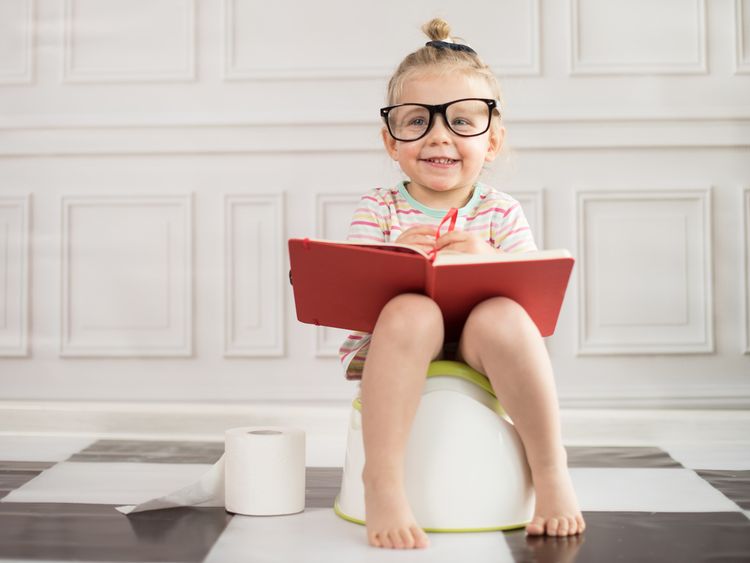7 Steps To Resolving Your Child’s Constipation

What goes in your mouth affects the frequency with which something comes out of the other end. Pretty simple when I put it that way, right? If only it were that simple in real life!
While you try to feed your children the best diet possible, no diet is perfect and kids always find ways to deviate from your health-conscious dietary fantasies. The result of that deviation is often times constipation.
Children can become very uncomfortable when they’re unable to go to the bathroom, which is something no parent likes to see. Thankfully, there are measures that can be taken to help alleviate your child’s constipation naturally and without the use of potent medications.
The Over-Prescription of Laxatives
While laxatives can help a child’s constipation on a temporary basis, they’re relied on far too often and far too quickly. The directions on Miralax’s packaging advise to take the product for up to a maximum of seven days. Parents sometimes give Miralax to their children for well over fifteen days, which is just wild.
When Miralax was tested in a laboratory setting, it was found to have trace amounts of ethylene glycol, which is the main ingredient in antifreeze! There have been reported cases of children with blood acidity stemming from Miralax use, which is just another reason to avoid such medical “solutions.” The last thing you need is for your kids to develop much more serious health complications stemming from your attempts to resolve their constipation.
While a child’s body and nervous system are still developing, it would be wise to only give them laxatives on rare occasions. There are plenty of other options to resolve your child’s constipation without resorting to more serious medications.
7 Steps to Treating Constipation Naturally
Consider giving your children a laxative if they’ve been constipated for close to a week. Before resorting to that, there are several alternative solutions to increase bowel movements naturally. Following some of these cues can also help to resolve underlying causes.

1) Avoid These Foods
A simple elimination diet is a great place to start, and gluten and dairy should be the first foods to go when your children are constipated. Pasteurized dairy products can contribute to your childrens’ inability to have regular bowel movements, as you may not know it yet, but they could be suffering from lactose intolerance, resulting in a backed up digestive system.
Fried foods can also contribute to constipation. If and when you find yourself dining out with your children, be sure to replace a side of fries with an alternative such as apple slices. If you want to do your kids an overall health favor, skip fast food eateries altogether.
2) Eat These Foods
Eating high-fiber foods is a natural way to increase your child’s bowel movements. Good high-fiber choices include nuts, beans, seeds, and raw vegetables and fruits.
Chia seed is a slightly laxative food and can be very helpful in relieving constipation. Just make sure to give it in a ratio of eight parts liquid to one part chia, otherwise it’s capable of absorbing water from your child’s intestines and compounding the constipation problem! Psyllium and plantain seeds are also known to have a laxative effect, so mix these into your child’s favorite juice or smoothie.
Warm beverages, especially first thing in the morning, can assist in improving digestive function. Brew your child a glass of herbal tea or even bone broth first thing in the morning. Drinking water regularly should also be part of your child’s daily routine. Water is going to help fiber pass through the digestive system, which will promote healthy bowel habits.
Feed your kids plenty of leafy green vegetables, such as kale, spinach, chard and bok choy, as they’re chock full of fiber and magnesium. If your child is a fan of dried fruits, encourage them to eat prunes or figs on a semi-regular basis. Both are known for being high in fiber and have an almost laxative effect on people shortly after being consumed.
A bully at school, a tough homework assignment, or even the pursuit of a first crush can result in real stress. This stress can lead to constipation. Belly massages can be very calming for children, and can also relieve constipation. Simply massage your child’s belly in a firm but comfortable manner for about five minutes. You can even use a small amount of massage oil to make the massage more pleasant.

4) Dedicated Potty Time
Like many other things that are important in life, pooping is a commitment – so make the time! Shortly after a meal, your child should naturally want to go to the bathroom, so this is an ideal time to encourage them to do their thing. Make them feel comfortable by reading them a story or giving them a tablet to play with. This should go on for ten minutes or less. If after ten minutes the magic isn’t happening, then it probably isn’t happening at all.
5) Squatty Potty / Baby Bjorn
This device is placed around the bottom area of a toilet and allows your children to elevate their feet into a squatting position. It’s gained immense popularity over the last few years, as it’s been proven to position the body ideally for passing a bowel movement without strain. This is the natural position humans had assumed for thousands of years until the toilets we use today were invented in the 1700’s. That’s right – before that, we were all squatters, including our kids.
6) The Potty Chat
It’s a good idea to sit your children down and let them know that it’s cool to use the bathroom when they feel the need to go, even if it’s at a friend’s place or in a public restroom. Going to the bathroom is something that a child shouldn’t feel embarrassed about, and the only way to drive that point home is to make it clear that bathroom trips are a natural part of life for everyone.

7) Try These Herbs, Supplements, and Essential Oils
Before resorting to potent medications, many parents have had success with certain oils, herbs and supplements first. These are safer to consume on a regular basis and are readily available at many health food stores. Here are some common solutions to consider:
- Magnesium Citrate: This works much in the same way that Miralax does, by pulling water into the intestines. It’s best taken right before bed, so that it can yield a solid bowel movement the following morning. Dosing is typically as follows:
1-3 years old: 65 mg/day
4-8 years old: 110 mg/day
9-18 years old: 350 mg/day - Probiotics and Prebiotics: Probiotics should be consumed on a daily basis to help maintain digestive health through bacterial balance. The gut is comprised of good and bad bacteria, and probiotics taken either through supplementation or fermented foods can keep the good to bad ratio in order. Additionally, prebiotics might be just as important, as they feed probiotics.
- Aloe Vera Juice: This juice is known for reducing inflammation, which is one of the main causes of constipation. You can give your child ¼ cup twice daily, with or without water.
- Ginger, peppermint and fennel essential oils can soothe your child’s digestive tract, which will be both calming and supportive of the colon.
The Bottom Line
Miralax and other laxatives have their place, there’s no doubt about it, as do many other potent drugs and medical interventions. With such a vast array of natural solutions to attempt, laxatives should be a tool reserved for only urgent situations. With the ideas outlined above, you should have a lot to go on before opting to bring out the heavy artillery.
